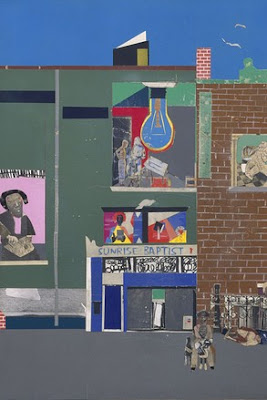 By DAVID YEZZI
By DAVID YEZZI
New York
Not long before Romare Bearden’s first major museum retrospective opened at the Museum of Modern Art in 1971, he peered out from a friend’s window overlooking Lennox Avenue in Harlem and made a few small sketches. The friend was the writer and critic Albert Murray, and the sure-handed, vibrant drawings—made with an array of brightly colored felt-tip pens—became the basis for Bearden’s iconic collage “The Block,” a series of six panels depicting low-rise buildings and storefronts on a single block between 132nd and 133rd Streets. “The Block,” along with a clutch of preliminary sketches, is now on view for a limited time at the Metropolitan Museum of Art.
Bearden, who succumbed to bone cancer in 1988, was a master draftsman and painter (whose line and palette sometimes recall Matisse), but it is his prismatic collages of blacks in America, populated with evocative elliptical narratives, for which he is best remembered. The pasted-paper compositions adorning the Masonite fiberboards of “The Block”—originally connected horizontally, now individually framed and preserved behind glass—show a cross-section of African-American life and culture north of 110th Street: apartments, stoops, a church, a barbershop, a liquor store, a funeral home.
Bearden’s buildings barely contain the teeming life within them, as figures composed of paint, colored and metallic paper, fabric, and cut-up photographs and Photostats spill out onto the sidewalks. Bearden’s subject is not, finally, bricks and mortar but experience. As he explained at the time: “When I sketched this block, I was looking at a particular street, but as I translated it into visual form it became something else. I lost the literalness and moved into where my imagination took me.” Bearden envisions—often through mullioned windows or cut-away sections of facade—lovemaking, worship, children at play and, more fantastically, an Annunciation and angels carrying a haloed figure aloft. We see lovers kissing, a homeless man sleeping, a hunched figure sitting alone.
Bearden looks past the buildings themselves to “the lives they contained within their walls.” Behind brick exteriors, a figure reclines in a bathtub as, a few windows down, another rises awkwardly from a bed. Bearden allows us to peer into living rooms and kitchens, each one populated with distinct characters and each with a story to tell. (All six panels are bracketed from below by gray slabs of street and from above by sky blues alternately day-lit and crepuscular.)
Bearden’s Cubist-inflected compositions draw inspiration from modernist masters such as Picasso and Braque (both of whom he met in Paris while studying at the Sorbonne on the G.I. Bill in the ’50s). But Bearden Americanized Cubist collage and made it his own, bringing to the medium his signature brand of storytelling. Harlem is where Bearden grew up and where he eventually had a studio. His genius for gesture and (often autobiographical) anecdote infuses his work with a personal emotional charge, while his formal control allows his domestic scenes to be intimate without becoming corny. As the playwright August Wilson, who owed a great debt to Bearden, put it, “From Romare Bearden I learned that the fullness and richness of everyday ritual life can be rendered without compromise or sentimentality.”
Like his friend the painter Stuart Davis, Bearden was passionate about jazz (he co-wrote the hit song “Sea Breeze,” recorded by Dizzy Gillespie). The jazz techniques of call and response and serial improvisation and variation find a visual corollary in Bearden’s work: He likened his shapes to the spaces between the notes. Rhythm provides the key to Bearden’s work. “The Block” takes its life from the energetic interplay of colored rectangles and the curves introduced by cut-paper figures, lampposts, architectural ornament, letters, clouds. Note, for example, the procession of yellow disks as they recur in the work, appearing first as a halo, then as either a sun or moon glimpsed above the rooftops and through a bedroom window, then in a scene on TV, and finally as the light atop a barber pole.
Color creates another dynamic rhythm in Bearden’s work. Bearden was a commanding colorist: the faded passages of painted paper—muted and rubbed blues, purples, browns and sea greens—make palpable the grit of pavement and old brick. Within his deftly colored structures, Bearden distills action and character with breathtaking economy and energy—whether the figures are running, recumbent, limping or laughing. The results are frequently surprising: a child nearly enveloped by the enormous hands of his father, the huge face of a heavy-lidded boy looking out from behind a half-lowered shade.
If Bearden is now not as widely renowned as his Pop contemporaries, it may be the fault of his abiding seriousness. While artists after Warhol succumbed increasingly to the siren-song of irony and kitsch, Bearden remained true to his modernist vision, to tradition and continuity. As the critic Hilton Kramer noted, Bearden makes use of forms that “derive originally from African art, then passed into modern art by way of Cubism, and are now being employed to evoke a mode of African-American experience.” Bearden was serious about his inheritance and about what he bequeathed. As one percipient reviewer put it, Bearden “is not playing games. With a gentle sympathy, he explores his culture and our culture with the delicate sensuality of a good physician feeling for broken bones.”
Part of the Met’s collection since 1978, “The Block” is a work of permanence and affective power. But it can only be seen for another two weeks before it heads back to storage. Because of the fragile nature of “The Block”—composed largely of pasted paper susceptible to fading—it tends to be shown for only a few months at a time, every five or so years. It is worth a special trip just to see it.
—Mr. Yezzi is executive editor of The New Criterion. His latest book is “Azores: Poems.”
